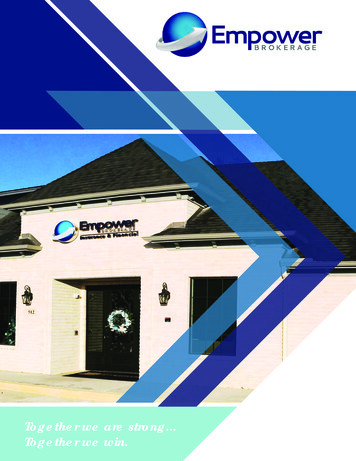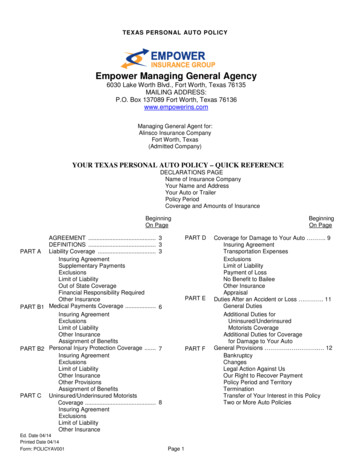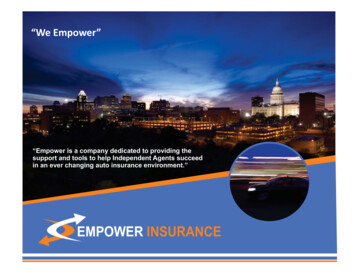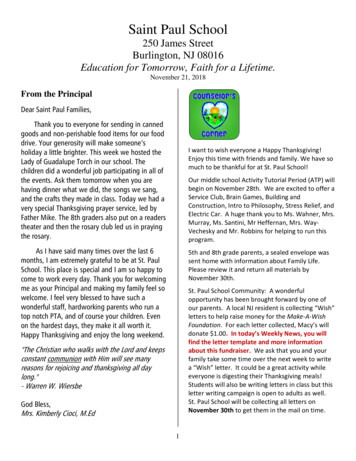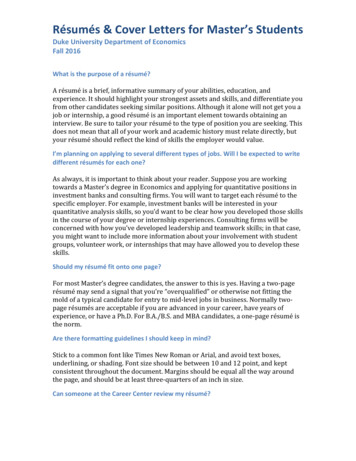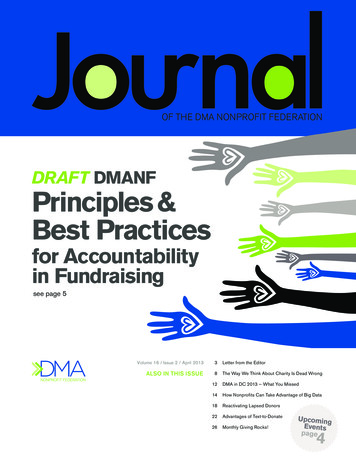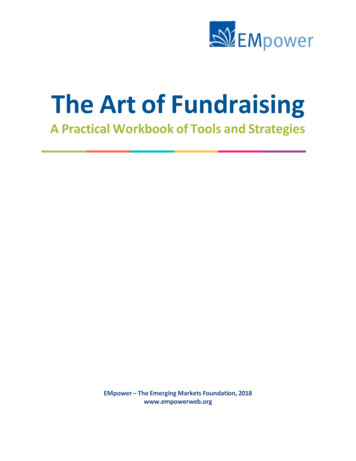
Transcription
The Art of FundraisingA Practical Workbook of Tools and StrategiesEMpower – The Emerging Markets Foundation, 2018www.empowerweb.org
AcknowledgementsThis resource was prepared as a workbook for a Learning Journey on Fundraising, held in New Delhi, Indiain April 2016 and re-worked for a Learning Journey on Fundraising held in Cape Town, South Africa inFebruary 2018. It was authored by Neha Broota, Development Manager, EMpower, who served as thelead resource for the Learning Journey, co-facilitating with Nisha Dhawan, Senior India Program Officer,EMpower. The workbook included tools and guidance on fundraising provided by Elizabeth Buck,volunteer at EMpower in the UK, Ciara Masterson, Development Manager at EMpower, Aasha Pai,EMpower Board Director in Hong Kong, and I. Neha and Nisha pulled together all the content into adigestible workbook for all workshop participants.EMpower realized that the guidance and tools in the workbook had broader applicability outside India,and indeed fundraising is a challenge for many of our grantee partners. And, based on experience, evenwhen the guide is simple, we know that it “takes a village” to produce a practical, user-friendly resource.This workbook is not intended to be an exhaustive guide to fundraising for small nonprofits. Rather, it isintended to help small organizations overcome their fears about fundraising, re-conceptualize how theycan fundraise, think about the most effective approaches given their capacity and context, and have someconcrete ideas about how to strengthen their fundraising strategies and tactics. Simple exercises areincluded to help organizations translate the theory into practice.We are grateful for the many resources we drew upon to produce this guide.Cynthia SteeleExecutive Vice President, EMpowerEMpower –The Emerging Markets Foundation2
Table of ContentsIntroduction4The Philosophy of Fundraising5Guide to Writing a Fundraising Strategy11Change your Perceptions and Create a Culture of Fundraising25What to Look for when Hiring Fundraising Staff33Writing a Case for Support35Stewardship43Advantages and Disadvantages of Different Fundraising Strategies49The ‘Art’ of Fundraising56Reconsider the Concept of Overhead64Tools to help you fundraise68Elevator pitchReferencesEMpower –The Emerging Markets Foundation70723
IntroductionThis workbook provides best practices, useful articles, exercises and references to assist our grantee partners infundraising, which can be challenging.This workbook has been used at past fundraising workshops for EMpower grantee partners with the aim to: Understand the landscape for fundraising and prioritize the most promising strategies for theirorganizations Gain an in-depth focus on the best way to fundraise in a corporate social responsibility (CSR)environment. Recognize the importance of dedicated fundraising capacity (staff, consultant or long-term volunteer,with a focus on fundraising).This workbook is intended to provide a medley of resources and ideas so that organizations can benefit from thewisdom and ideas of others. We scouted a range of materials to uncover tools and resources that could be usefulwhen thinking about fundraising. Permissions were sought and citations given for all materials in this workbook, aswe want to credit the original sources. In some cases, where allowable, materials were adapted.Each section of the workbook contains: Notes from different resources. A short exercise to complete.At the end are some great resources that we recommend for further reading.EMpower –The Emerging Markets Foundation4
The philosophy of fundraising1Taming the demon - fundraising and transformationA big part of the reason we sometimes feel haunted by the fundraising demon is because we lose sight of whatfundraising is all about. At the most basic level, fundraising is about asking people for money. That helps explain theemotions we associate with fundraising. Many of us have painful relationships with money. The idea of talking aboutmoney with someone you hardly know can feel intimidating.But is money the focus of your life, your aspiration, your career? It takes just a moment’s reflection to realize thatmoney is simply a means to an end. And what is that end? One answer is the particular goal of your organization.The immediate short-term goals may be very specific: to meet operating budget, to create an endowment. But theshort-term goal is often subservient to a more ambitious long-term goal: to alleviate hunger, educate more children.Being continually aware of this much bigger reason for the work we do is one big step towards taming the demon.Asking for money evokes scary, unpleasant emotions, but working to make the world a better place is exhilarating,inspiring and energizing. Fundraising is not just asking for money - it is a vehicle for transformation - personal,organizational, social and even global. Broadening your perspective on fundraising to embrace the need for personaland social transformation can be liberating. It is about making a difference in the world through creative humanconnections. Fundraising is about energy, creativity, human connections and joy. That means touching the desires,dreams and yearnings that are much bigger than your own goals, ambitions and challenges.The Game Changer – make the conversation not centered on moneyConcentrate on how people want to make a difference with their life - this is the goal of the conversation.Suddenly the conversation is not about money, but the start of an open-ended, unfolding journey. Are youinterested in learning what someone really cares about? Their life, their work, their dreams, their passions? Themeeting will then be more creative and interesting. When meeting someone - it is about two people sitting downtogether and having a deep conversation about their lives and about what they can do together that might becreative, exciting, rewarding and fun.Fundraising and the universal quest for meaning – it is EMOTIONAL Why is it that getting people to give money can feel so difficult - even when we have a watertight, logicalcase to make that demonstrates the importance of our cause, the effectiveness of our program, and thevalue of our work? It is because people don’t give for logical reasons. Research shows that peopleconnect themselves to a cause overwhelmingly for emotional reasons rather than objective, logical ones.This is why fact-based appeals used by many nonprofit fundraisers are generally ineffective. People become dedicated to causes that change their self-image and make their lives feel rich withmeaning. We should appeal to the innate human meaning for emotional fulfilment on behalf of theworld-changing causes we serve. If you want to turn people into passionate partners for your cause, focuson providing a promise of partnerships and personal growth, also with an avenue of achieving them.1This section was drawn and adapted from: "The Generosity Network: new transformational tools for successfulfund-raising" by Jeffrey C. Walker, Jennifer McCrea and Karl Weber (24th September 2013).http://www.thegenerositynetwork.com/EMpower –The Emerging Markets Foundation5
People want to make a difference with their lives and with their money. They want to work together andto share their passions with like-minded individuals, and that is why philanthropy grows from deep-seatedhuman needs. That is the only secret. Once you understand that people want to make a difference on theplanet - even if they are not aware of it yet - you realize that the act of fundraising is not difficult, painfulor frightening but is in fact deeply meaningful work.Four realities of givingGiving is emotional. People are inherently generous, and they are driven to giveby emotional factors. This familiar truth is often ignored by many who focus onstatistics and charts rather than human faces.Giving is personal. Social psychologists tell the story of a tank full of brine shrimpbeing neglected in an elementary school classroom. The kids ignored the slowdeaths of the shrimp until only one survivor was left - whom the kids named,anthropomorphized, and eagerly began to care for. This seems illogical, yet itreflects human nature: people want to help one person, not a mass. The goodnews -- modern technologies, from social media to mobile communications,make it easy to connect would-be donors to individual recipients and so triggerthe instinct to help.Giving makes people happy. When we help other people our brains releaseendorphins, producing an emotional sensation often called “the helper’s high”.This encourages people to give again -- a beneficial form of addiction that nonprofits can help reinforce by providing tangible evidence of the positive resultsgenerated by giving.Giving is social. When a clear plastic donation box is displayed in a museumlobby, people tend to make the same kinds of gifts they see. If the box is empty,they give nothing; if it is filled with coins, they give coins, if is full of bills they givebills. Similarly, public radio stations find that listeners become donors when theyhear stories about people like themselves making contributions.EMpower –The Emerging Markets Foundation6
Overcoming the obstacles that block the flow of resourcesObstacle 1: Scarcity Many fundraisers are hamstrung by the belief that money is a scarce commodity. Yes, we live in economic uncertainty, but the fact is that today we have access to an incredibly vast poolof financial resources, real and potential. Did you know that during the first half of the 21st century, individuals are expected to contribute toprivate foundations more than ten times the amount of money they contributed in the preceding onehundred years? There is plenty of wealth in our society, much of it eagerly seeking a positive outlet. The same is true for resources: time, networks, creativity, ideas, passion. The doctrine of scarcity fosters an attitude of anxiety, fear and needless competitiveness among nonprofitmanagers. SO not only is it inaccurate, it’s also harmful.Obstacle 2: Despair The challenges we face are big - but we mustn't let this fact drive us to despair and inaction. Despair is the mind’s way of keeping a safe distance of telling itself that nothing can be done. Of course it is true that our species faces serious problems that will take enormous efforts to fix. That isone reason so many of us have chosen to devote our lives to addressing them. It is also true that humankind has surmounted incredible challenges in the past e.g. eradicating smallpox. No one person is saddled with the responsibility of resolving any of our greatest problems alone. Rather,each of us carries the burden of making things better in our own chosen atmosphere. Defined in a narrow way, the tasks we face are eminently manageable and the results, multiplied byhundreds of thousands of nonprofit organizations and millions of individual volunteers, can be trulyimpressive.Obstacle 3: Fear of Unknown Reaching out to make real human connections can be intimidating at first. A common reaction is to flee from spontaneity and authenticity into a world of regiment, planning andcontrol. Rather than speaking from the heart and with an open mind, we take refuge in the comfortingconcept of a thirty second elevator pitch. Touting an agreed-upon organizational line does not touch people. It does not establish an emotionalbond, it certainly does not offer a promise of personal or organizational transformation. When seeking resources for the cause you love, don’t be afraid to let go of some control. Bring your true self and the stories that encapsulate it to the table. Yes, this kind of transparency can make you feel vulnerable. But it is also exhilarating and in the long runIt’s the only way that you and the organizations you care for are really going to grow.EMpower –The Emerging Markets Foundation7
Obstacle 4: Fear of Rejection It hurts to be turned down, but if you remember that people really do want to make a difference on theplanet with their money, you realize that rejection is fundamentally impossible. This claim is hard to believe and flies in the face of what every fundraiser knows. But remember ourdefinition of fundraising: it is not about money, it is about transformation. If your goal is larger than just directing resources to your own cause- if your goal is to guide people to lookinside themselves and discover what they truly care about, as part of their personal journey to atransformed more meaningful existence- then there is no possibility of rejection. What masquerades as rejection is really just the flow of resources into a different channel. Suppose you are raising money for poverty eradication. It may happen that the person you meet ends upbeing interested in art. Is this an experience of rejection or failure? If you’ve entered the dialogue with theattitude – it’s all about the money, then you will surely take it that way and you will be on your way tofundraising burnout. Instead, learn to take a different mindset to recognize that your acquaintance’s self-discovery is positivefor the world not the rejection of you and your organization.The world needs people mobilizing resources for a wide range of wonderfully important things includingart. Try responding with a heartfelt, “How wonderful!” and perhaps offer a couple of contacts who might beable to help with her/his quest to become a patron of the arts. Scarcity, despair, fear of the unknown and fear of rejection all make fundraising difficult. Once you stop allowing these obstacles to stand in your way, you may experience a flow of energy.EMpower –The Emerging Markets Foundation8
Exercises to think about the philosophy of fundraisingReflect on the following questions:1. What is fundraising?2.How do you feel about fundraising?3.What makes fundraising so hard?4.What strategies are you comfortable with and not comfortable with (currently) when it comes tofundraising?5.Which one of the obstacles has the greatest impact on your work and why?6.Think about encounters you have experienced; recall one that was unproductive. How can you re-write itand make it productive based on the results above?Reflection questions1.What is money’s role in my life? Am I comfortable talking openly about it? Why or why not?2.Do I think of money as a scorecard or as a resource to be used for things I care about?3.Is my attitude towards money shaped by my fear of being dependent on others?4.Do I ever use money to control other or to buy their respect or affection?5.Am I willing to redefine what wealth means to me?6.How do you spend your money?7.What does it feel like when someone asks you for money?8.How willing are you to open up to other people?9.What are your deepest beliefs about the meaning of success and failure?10. What are the unspoken values that shape your most powerful drivers?11. Am I willing to take a risk with others – become vulnerable, enter a true relationship with them?12. Am I willing to see my partners and potential partners as fully human?13. Am I willing to allow others to find their own passions, even passions I may not share?14. Am I willing to be the kind of person who finds continual opportunity, growth, and community as part of ateam working on a common cause?EMpower –The Emerging Markets Foundation9
Guide to Writing aFundraising Strategy2What is a Fundraising Strategy?A fundraising strategy outlines actions, time frames and resources to meet the organization’s key objectives,outlined in a strategic plan (sometimes encompassing a business plan also). A strategy helps prevent wasting timeand resources by outlining priorities and helping to align everyone’s work around those priorities.Your fundraising strategy should be a working document that staff and the management team use to review andlearn from successes and develop future recommendations. Generally, a fundraising strategy covers between athree- and five-year period (and ideally is linked to a strategic plan or woven into a business plan for the sameperiod). It is possible for individual projects of larger scope to have a separate fundraising strategy.Common contents of a Fundraising Strategy Mission Statement. Current Position. Links to Organizational Planning. Current Income. Raising Money. Review and Monitor.Mission StatementSummary of your organization. It should concisely state the purpose of your organization, what it provides, theneeds it meets, its core values and intended outcomesCurrent IncomeUsing your current year’s budget, pull out income broken down by each source. Indicate when each is due to endand your best estimate on the likelihood of obtaining further funding from current funding sources. Scanunsuccessful fundraising attempts, and the reasons why funding could not be obtained from these sources – is itworth trying again or are there lessons learned to inform the fundraising strategy?Planning how to raise what you needNext, you will need to decide which sources are the most promising for you to raise funding from in the currentyear. List these potential funders and the level and type of support they provide, as well as the amount that youwill be applying for, and relevant dates for deadlines or funding awards. Under-estimating the direct costs of aproject can lead to a lack of funding to cover the necessary resources and could threaten the project. In additionto the costs associated with the delivery of your project, use the “Full Cost Recovery” approach to recover a2Article: "A guide to writing a fundraising strategy" by Klair Price, GRANTfinder Senior Information Researcher,2013. Permission to include - note on the website "Reproduction is authorized, except for commercial purposes,provided that the source is mentioned and acknowledged. Idox claims no copyright on any official document."EMpower –The Emerging Markets Foundation11
relevant proportion of the organizational overhead. These costs should be divided up so that the total yearlyoverhead costs are covered by funding from the individual projects.Review and MonitorAll fundraising activities should be monitored in a timely manner as the realization of funds is key to all aspects ofthe organization’s plans. Providing a financial breakdown of the actual costs at each stage against the amount ofmoney raised will provide details of cost effectiveness of each activity. This will enable comparisons betweenactivities to assess which are most promising, which take the most time or may be unrealistic at this time. Thisassessment will inform future fundraising efforts and will alert you to any areas where assistance may be needed,such as devising better budgets or writing a grant application.Deciding Who Should FundraiseNot many organizations, especially if small, are able to dedicate a full-time position to fundraising, therefore thetask tends to be carried out by various staff members. As there are numerous aspects to fundraising, the skills ofdifferent individuals can be harnessed for varied aspects involved. One person may be really strong atconceptualizing and writing up program proposals, whereas another may be an organizational whiz able to planand implement an event. You will need a staff team that collectively possesses strong written and verbalcommunication skills for preparing budgets, writing grant applications, speaking to funders and organizing events.Some fundraising skills can also be outsourced to a fundraising consultant or professional fundraiser however staffare needed to provide input on the organization’s work as well representing the organization (generally alsomaking the Ask).To ConcludeYour fundraising strategy should be one of the most important documents you will write for your organization. It isa useful working document that is able to respond to changes that occur within the funding environment or withinyour organization. It is a major determinant of the success and sustainability of any organization. It doesn’t haveto be Shakespeare’s prose but should be a living guide to how you plan to raise needed funds. It will enable you to: identify all the costs associated with each project or activity so that your organization reaches its intendedoutcomes.strategically plan how you will raise funds for each part of the projects you intend to carry outensure that all staff are clear on their involvement.outline deadlines for submitting grant applications and timescales for stages of progress to be adhered to,which will allow staff to plan their workloads.EMpower –The Emerging Markets Foundation12
Fundraising strategy templateBackgroundThis section helps you focus on why you need to raise the funds you do and should have the following information: What is your organization’s mission? What initiatives you are planning on fundraising for? What do you plan to do with the money you raise? Key achievements of the program to dateFundraising overview – Where are you now?1.How did it go last year, what about the previous years, what worked well, what did not work well?E.g. We now have the track record and credibility to engage confidently with other funders and thoughtleaders in order to leverage support. We did not spend enough time researching fundraising tools anddeveloping additional activities to continue the expansion of our program and influence the donorcommunity.2.What are the external threats?E.g. Are there other organizations carrying out similar work in your areas3.Identify areas of untapped potential or gaps that need to be addressed4.What are your current sources of funding?E.g. Using your current year’s budget, pull your income broken down by each source.Indicate when each is due to end and your best estimate on the likelihood of obtaining further funding fromcurrent funding sources.Scan unsuccessful fundraising attempts, and the reasons why funding could not be obtained from thesesources – is it worth trying again or are there lessons learned to inform the fundraising strategy?5.What are strengths within your organization?E.g. the reputation of your organization or the fundraising skills of staff members, track record of success,trust of the community, actions/services that only your provide etc.6.What are your fundraising resources?E.g. provide an indication of what resources you have and might need to successfully implement your plan.7.MeasurementE.g Measure aspects of your current fundraising, such as the attrition rate (% of donors that are lost in agiven period), response rates–(e.g. on Christmas appeals) and return on investment.The ‘fundraising ratio’ between what you spend on fundraising efforts (in different forms, such as grantapplications vs. events) and how much goes towards the cause.EMpower –The Emerging Markets Foundation13
Fundraising Goal/ Objectives – Where do you want to be?The best starting point for your plan is with the end in mind: what is your overall fundraising goal? (Even better,what is your overall fundraising goal for this year, and for each of the next four years?).This number should be based on the needs of the organization. How much money will your group need to raise inorder to carry out the activities that you want to carry out? Where the organization envisions itself in the future andwhat is the organizations current state?These should link in with the organizational objectives. Ensure that your fundraising targets are based on thoroughanalysis, realistic and achievable objectives.Fundraising Approach - How do you get there?Once you know how much you need to raise and why you need to raise it, you need to figure out how you are goingto raise the full amount.What tactics will you use to raise your goal amount this year? Next year? The year after? Go into detail here, andfigure out a goal for each of the tactics that adds up to your total goal. (For example, if you need to raise 5,000 youmay say that you will raise 3,000 through a major donor group and 2,000 through an event).Keep in mind that there are no shortages of tactics, only a limited amount of staff and volunteer resources toimplement your ideas. Try to include a good mix of fundraising tactics, and be willing to mix ideas that end up notworking, and make up the lost revenue elsewhere. You will also need to include the acceptable costs of raising thesefunds from the various sources.For example:Create a plan of action: Fundraising target (raise 100,000, renew 65% of donors, acquire 500 new donors) - whichthen leads toThe fundraising strategy ( raise 25k through foundations, raise 50k through major gifts, raise 25k through individualdonors) – which then leads toThe action plans (strategy, description, target audience, goal, cost, who will do and by when, what resources areneeded)Other Points You should aim to approach as many funders as possible to increase your chances of success and diversifyyour funding sources. Being heavily dependent on one or two funding streams could be of detriment to your organization shouldthese sources be withdrawn or dry up. All potential funders and the level and type of support they provide should be listed next to the aspects ofeach project, stating the amount that you will be applying for. You should also state the relevant deadline dates and the length of time before they respond to you as thiswill enable you to set a realistic project start date. An important aspect to remember is to calculate the costs of each project with precision. Underestimatingthe direct costs of a project can lead to a lack of funding to cover the necessary resources and couldthreaten the project. Whilst you may successfully calculate the costs associated with the delivery of your project, failing to coverall of the associated day-to-day organizational costs could ultimately put your organization at risk anddecrease any chances of sustainability. Project costs should also include the relevant proportion of overheads. These costs should be divided up sothat the total yearly overhead costs are covered by funding from the individual projects.EMpower –The Emerging Markets Foundation14
Ways to present the data1.Identify sources of funding (old and new)Source r goalsGoalStrategyHow will you measure itIncrease donor retention by 50%Increase Board involvement infundraisingORTIMING:Year-roundGOAL: 10,000 (5 new donors at 2,000 each); Increase number of mid-leveldonors by 10%NO. PROSPECTS:TBDSTRATEGY:Focus on strengthening mid-level donor relationships to transition themto major gifts in the future. This will be achieved through increasedpersonal visits and targeting engagement by areas of interest. Cultivatethrough events, face-to-face meetings, select invitations to NEXT GEN topace gifts and transition to Major Gift level within three (3) years.TACTICS:1.2.3.4.5.6.RESPONSIBILITY:Compile prospect list of 20-30 high level prospects (list reviewwith BOD)Qualify prospects and begin outreach to Top 10Arrange initial meetingsDevelop individual cultivation plansDevelop case for support and collateral materials on programareas for funding i.e. geographic, program or issue specific.Work cultivation plans during the yearDevelopment ManagerEMpower –The Emerging Markets Foundation15
TimingMany organizations stumble here – they come up with a solid budget, have a great mission, and draw up a planthat includes a solid group of fundraising tactics, but fail to set timelines, and thus never seem to get things done.Some development pros like plans that have only basic timelines: Hold an event in April, send out a mailing inSeptember, run a board giving campaign in November.However, a more detailed timeline that lists not only the big picture goals, but also all the small goals that go intomaking that big goal a reality will be helpful. For example, instead of just listing that we are having an event in April,you could also list when decisions on venue and entertainment need to be made, when sponsors will be solicited,when invitations will go out, etc.Whichever type of timeline you include, include one it will force you to think critically through your fundraisingdecisions, and provide invaluable guidance on your activities as the year progresses.Description of WorkStart and End DatesPhase OnePhase TwoPhase ThreeMonitoring and Review ProcessMonitoring and Evaluation will help you determine the success or failure of an initiative. It should be an ongoingprocess, rather than left until the end of the project.Your strategy should detail how you will keep records, demonstrate learning from aspects of your fundraisinginitiatives that did not work, and improve on your successes.Your fundraising strategy should be the subject of a regular review so that it may be updated and modified torespond to any changes that occur. This could be in relation to current or new funding opportunities or with regardto changes within your organization.Providing a financial breakdown of the actual costs at each stage against the amount of money raised will providedetails of cost effectiveness of each activity. This will enable comparisons to be made between activities to assess ifthe fundraising targets were under- or overambitious. This assessment will inform future fundraising efforts and willalert you to any areas where assistance may be needed, such as devising better budgets or writing a grantapplication.To ConcludeYour fundraising strategy should be one of the most important documents you will write for your organization. It isa useful working document that is able to respond to changes that occur within the funding environment or withinyour organization. It is a major determinant of the success and sustainability of any organization. It doesn’t have tobe Shakespeare’s prose but should be a living guide to how you plan to raise needed funds. It will enable you to: Identify all the costs associated with each project or activity so that your organization reaches itsinte
The workbook included tools and guidance on fundraising provided by Elizabeth Buck, volunteer at EMpower in the UK, Ciara Masterson, Development Manager at EMpower, Aasha Pai, EMpower Board Director in Hong Kong, and I. Neha and Nisha pulled together all the content into a digestible

